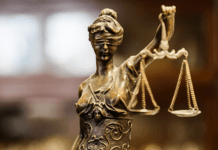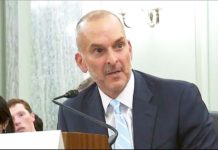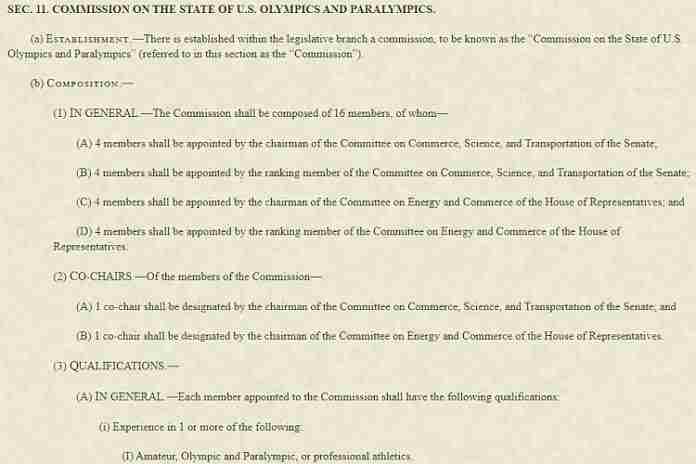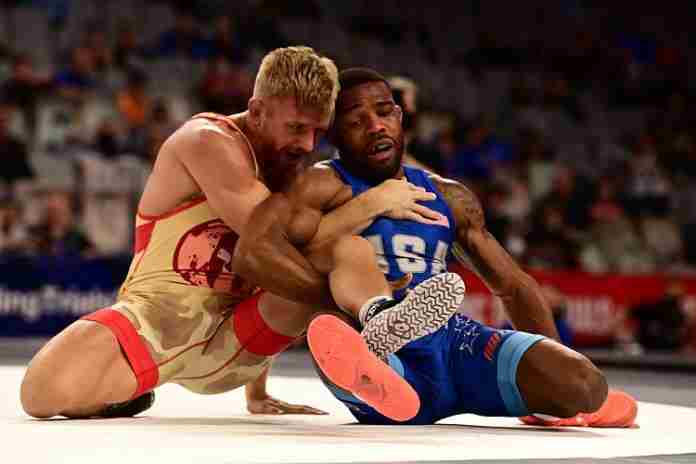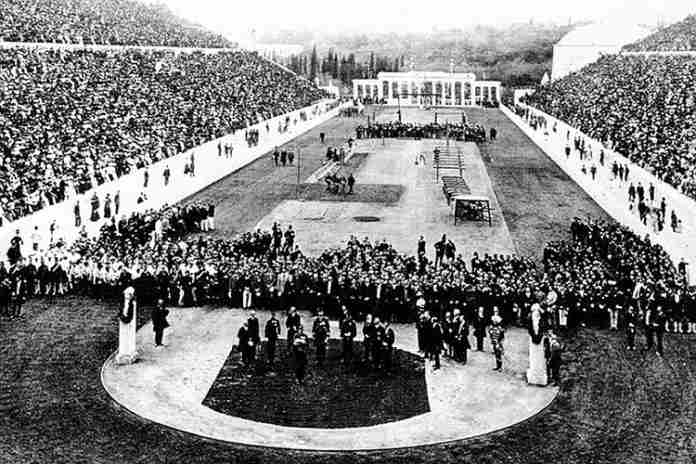The Empowering Olympic, Paralympic and Amateur Athletes Act of 2020 (EOPAAA: S. 2330) became law on 30 October last year and created the potentially powerful Commission on the Study of the U.S. Olympic and Paralympics.
Its membership was completed last Friday, so now what?
The Commission make-up includes 16 members, of whom there are eight women and eight men, and ten are current or former Olympic, Paralympic or Pan American Games athletes:
Olympians (6):
● John Dane (sailing)
● Benita Fitzgerald Mosley (track & field)
● Nancy Hogshead-Makar (swimming)
● Edwin Moses (track & field)
● Brittney Reese (track & field)
● Jordyn Wieber (gymnastics)
Paralympians (3):
● Patty Cisneros Prevo (basketball)
● Karin Korb (tennis)
● Melissa Stockwell (swimming & triathlon)
USOPC Athletes Advisory Council (1):
● Han Xiou (ex-Chair; played table tennis)
The six non-athlete members include:
● Rob Cohen, Chair of IMA Financial Group and a USOPC Foundation trustee;
● Mitch Daniels, former White House OMB Director; two-term Governor of Indiana;
● Bill Hybl, chief executive, El Pomar Foundation; twice USOC President;
● Dionne Koller, Professor of Law at the University of Baltimore;
● Rob Mullens, Athletics Director at the University of Oregon;
● Joe Schmitz, former Inspector General of the U.S. Dept. of Defense.
It’s a powerful group, and no one can say that the “athlete voice” is not well represented, with 10 of the 16 members (62.5%). Koller has been announced as a co-chair and Xiao could be the other.
Now, what will the Commission do? Its responsibilities are outlined in detail, including 10 specified items:
● “a review of the most recent reforms undertaken by the United States Olympic and Paralympic Committee;
● “a description of proposed reforms to the structure of the United States Olympic and Paralympic Committee;
● “an assessment as to whether the board of directors of the United States Olympic and Paralympic Committee includes diverse members, including athletes;
● “an assessment of United States athlete participation levels in the Olympic and Paralympic Games;
● “a description of the status of any United States Olympic and Paralympic Committee licensing arrangement;
● “an assessment as to whether the United States is achieving the goals for the Olympic and Paralympic Games set by the United States Olympic and Paralympic Committee;
● “an analysis of the participation in amateur athletics of (I) women; (II) disabled individuals; and (III) minorities;
● “a description of ongoing efforts by the United States Olympic and Paralympic Committee to recruit the Olympic and Paralympic Games to the United States;
● “an evaluation of the functions of the national governing bodies (as defined in section 220501 of title 36, United States Code) and an analysis of the responsiveness of the national governing bodies to athletes with respect to the duties of the national governing bodies under section 220524(a)(3) of title 36, United States Code; and
● “an assessment of the finances and the financial organization of the United States Olympic and Paralympic Committee.”
The Commission must meet within 30 days of the appointment of the final member, which means by 2 May 2021 and it will need to obtain funding and appoint a staff. It must hold at least one public hearing and has subpoena power. The Commission is charged with:
“Not later than 270 days after the date of the enactment of this Act, the Commission shall submit to Congress a report on the results of the study conducted … including a detailed statement of findings, conclusions, recommendations, and suggested policy changes.”
That would mean the Commission would have to finish its work by the end of July, while the Olympic Games in Tokyo are actually ongoing. That isn’t going to happen, and the deadline will no doubt be extended.
The Commission membership has a lot of athletes on it, but also some folks who know a lot about the U.S. Olympic & Paralympic Committee. Hybl was a two-time president of the organization, Fitzgerald Mosley was the organization’s Chief of Organizational Excellence and later Chief Operating Officer. As a USOPC Foundation trustee, Cohen has a deep knowledge of the organization’s finances.
Moses has a long and highly distinguished career as an athlete advocate, but also a deep commitment to anti-doping and is one of the most highly-respected people in the Olympic Movement. Wieber, at 25, is not only an Olympic gold medalist, but also a Larry Nassar survivor and will add an important perspective on athlete safety.
Hogshead-Makar is a civil-rights and athlete-rights attorney and has been a virulent critic of the USOPC. No one can say that the organization’s harshest critics do not have a seat at the table; it remains to be seen how effective she will be in promoting meaningful change.
So what are the priorities?
● Money. No surprise there; the USOPC lives off of a percentage of the U.S. television rights payments to the International Olympic Committee and the IOC’s TOP sponsors. The question is how the organization spends it – for example, is it worth having the Olympic training centers? Should Olympic team members be paid training stipends? – and whether any worthwhile effort has been made towards new funding opportunities.
● Structure. The EOPAAA required changes in athlete representation at the USOPC level and for the U.S. National Governing Bodies. Those have, or are being implemented, but the Commission could go further. At its core, the U.S. Olympic Movement is a volunteer organization built on the grass-roots work of thousands of people who help young athletes learn, train and compete in sports. Will they get any help?
● Role of the National Governing Bodies. How much support should be given to the NGBs vs. the USOPC in Colorado Springs? This will be a major discussion point, especially since the USOPC provides significant funding for many of the NGBs. Can some of the NGBs even handle more funding?
● IOC relations ● The EOPAAA is clearly in conflict with the Olympic Charter, in the sections which give the U.S. Congress the power, by joint resolution, to “dissolve” the USOPC Board of Directors or to “terminate the recognition” of a National Governing Body. The IOC is fully aware of these issues, but has other priorities at present; what will the Commission recommend?
● Goals. Perhaps this question will be the most discussed. The then-U.S. Olympic Committee emphasized Olympic Games performance over grass-roots programming many years ago and quickly became the top medal-winning National Olympic Committee at the Olympic Games. Will that change?
A key element of that discussion will be a consideration of the statutory instructions for the USOPC, the Ted Stevens Act Olympic and Amateur Sports Act, 36 U.S.C. 2205, originally passed as the Amateur Sports Act of 1978.
It’s clear from the USOPC’s actions over many years that it has only limited understanding of what’s in the Ted Stevens Act and the Congress has even less. That’s why the Commission would be well served by appointing the architect of the Amateur Sports Act, Mike Harrigan, as its Executive Director.
Harrigan lives in the Washington, D.C. area and has been continuously active in pushing for more attention to the Act’s requirements that no one pays attention to (for many years). With his help, both the Commission and the USOPC will get a much stronger grip on what the Act requires and what it can do to help the Olympic Movement in the U.S.
There are those who see the Commission as the instrument to deconstruct the USOPC, if not destroy it altogether. There is no doubt that the organization must continue to modernize and it has serious weaknesses, but the Commission itself is also on the spot: it has the burden of making the right choices and recommending the right fixes, or the onus of failure will be on it.
As the saying goes: “For to whom much is given, much shall be required.”
Rich Perelman
Editor
You can receive our exclusive TSX Report by e-mail by clicking here. You can also refer a friend by clicking here, and can donate here to keep this site going.
For our 649-event International Sports Calendar for 2021 and beyond, by date and by sport, click here!














